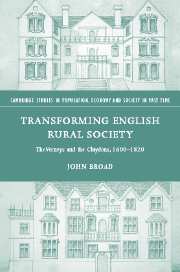Book contents
- Frontmatter
- Contents
- List of figures
- List of tables
- Preface
- Acknowledgements
- Note on editorial practice
- List of abbreviations
- 1 Introduction
- Part I Re-establishing a gentry family 1600–1657
- Part II The shaping of family and village 1657–1740
- Part III The great estate and estate communities c. 1700–1820
- 8 The rise and fall of Verney fortunes in the eighteenth century 1740–1820
- 9 Transforming the Claydons in the eighteenth century
- 10 Conclusion
- Appendix A Sir Ralph Verney's confessional letter of 1650
- Appendix B The genealogy of the Verney family
- Bibliography
- Index
8 - The rise and fall of Verney fortunes in the eighteenth century 1740–1820
Published online by Cambridge University Press: 03 July 2009
- Frontmatter
- Contents
- List of figures
- List of tables
- Preface
- Acknowledgements
- Note on editorial practice
- List of abbreviations
- 1 Introduction
- Part I Re-establishing a gentry family 1600–1657
- Part II The shaping of family and village 1657–1740
- Part III The great estate and estate communities c. 1700–1820
- 8 The rise and fall of Verney fortunes in the eighteenth century 1740–1820
- 9 Transforming the Claydons in the eighteenth century
- 10 Conclusion
- Appendix A Sir Ralph Verney's confessional letter of 1650
- Appendix B The genealogy of the Verney family
- Bibliography
- Index
Summary
The history of the Verney estates from 1740 to 1820 provides a spectacular example of aristocratic dissipation of wealth, indebtedness, and reconstruction. The second Earl Verney managed not only to consume the £70,000 in portions that he and his brother had received, plus the inheritance that his wife received from her father, but also to put the estate over £100,000 in debt. The management of that debt, and his successor's re-establishment of sound finances, meant that by 1820 a compact but much diminished landed estate remained, and permitted the nineteenth- and twentieth-century Verneys to play an important part in Buckinghamshire society and politics.
The second earl's enormous fortune had been built up over three generations, carefully marshalled by thrifty lifestyles, carefully planned marriages, and obedient elder sons, and brought to fruition by two spectacular heiress marriages. How was it dissipated in a single generation? There was no inherited financial crisis. In 1740 the Verneys were solvent, with resources spread between land and sound paper investments. Nor were there hidden family charges, liabilities to younger brothers and sisters, or crippling jointures, though there was the substantial family liability of £1,600 a year to John Verney's widow, and the prospect of raising a £20,000 dowry for her daughter. Yet £70,000 of new money more than compensated for this. Not all of it was instantly accessible. Of Mary Nicholson's £40,000, £20,000 was in cash, but the remainder was only payable on her father's death.
- Type
- Chapter
- Information
- Transforming English Rural SocietyThe Verneys and the Claydons, 1600–1820, pp. 199 - 227Publisher: Cambridge University PressPrint publication year: 2004



